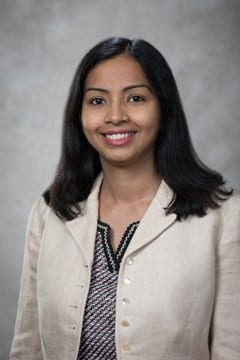Celebrating the Women of Arkansas BMEG.. Read their stories.
Dr. Xianghong Qian Dr. Young Hye Song Dr. Rebekah Samsonraj
What challenges have you faced on your path to a faculty position and how have you addressed them?
Qian: The major obstacle in my path to a faculty position is the two-body problem since my husband was a faculty member at Colorado State during my postdoctoral training at Max-Planck Institute in Germany.
Song: I think the time I spent trying to secure a faculty position was one of the craziest times of my life; juggling not only survival in the job market, but all my postdoc training duties, including my own research, grant writing and mentoring students, and life. The stress of it all was too much to handle on my own. Thankfully, I had help and encouragement from all kinds of people, including family, friends, mentors, mentees, and colleagues. I don’t think I would have survived otherwise.
Samsonraj: We are all aware that the postdoctoral years are a time of great attrition from the academic pipeline for women scientists. Data shows that women, especially those with children, tend to spend more time as postdocs than men, leading to a delayed entrance into the tenure-track. My path to a faculty position was met with challenges arising from integrating research, life, and parenting after having two babies during my stint as a postdoctoral researcher – a tough combination and a special kind of challenge that required much support from my institution, colleagues, mentors, and my family. Addressing these challenges involved several sacrifices made every single day on my path to secure a faculty position as I set my eyes on the goal and trained my mind to not lose sight of the purpose and mission of my calling to serve in academia. My workout instructor says, “If it doesn’t challenge you, it won’t change you”. I’m proud I’ve had the courage to become a better version of myself, and I’m definitely not finished learning. I’m grateful to everyone who has helped me get where I am, and I’m enjoying paying it forward.
The biomedical engineering discipline is unique and creative in that it requires active collaboration between multiple disciplines. What has been your experience with this?
Qian: I was lucky that I have a broad training in chemistry, physics and biology. As a computational scientist, I was able to work with experimentalists in different areas. Eventually, I decided to set up my own biotechnology laboratory after I moved to University of Arkansas.
Song: I think multidisciplinary collaboration is necessary in our field. I’ve been engaged in biomedical engineering research since my undergrad days, and it’s always been interdisciplinary. I’ve worked with people in so many different fields, including clinicians, food scientists, chemists, biologists, engineers in other disciplines, as well as biomedical engineers. Working with people from diverse backgrounds expands the scope of research in new ways that I hadn’t thought of, and I’ve learned so much from all of them. I look forward to continuing and expanding interdisciplinary collaborations as my research program evolves.
Samsonraj: Collaborations have been a vital part of my professional research career. In my several successful and productive collaborations, one thing has remained common: having a superordinate goal – a goal that is big enough and compelling enough to help us to overlook personal differences and transcends individual goals in order to achieve something of significance. I continue to thrive in all of the wonderful interdisciplinary biomedical collaborations I’ve established through the years. One of my wise mentors told me, “Choose your collaborators wisely – there are many takers but very few givers. Lean on the giving side but never let anyone take advantage of you”.
What about your BMEG experience are you most proud of and excited for?
Qian: I am very proud of the collaborators I am working with and the talented colleagues in my department. In particular, I am very excited to work on industrially relevant problems to help meet the challenges in the manufacturing of protein therapeutics and the emerging cell and gene therapies.
Song: The past year and a half I’ve spent here has been wonderful with everyone welcoming me in and willing to help me in all different ways. I am most proud of the students I have met in classes and research. They’re hardworking students that really appreciate their opportunities for higher education. I am excited to continue my journey as a faculty member in this department.
Samsonraj: I’m grateful and excited to be part of our vibrant BMEG community that embraces respect, integrity, teamwork, innovation, excellence, and kindness. These values are integral to succeed in academia.
If you could give your 17-year-old self a piece of advice related to pursuing a career in STEM, what would it be?
Qian: I would not put gender as an obstacle in pursuing one’s dream or career. If you have a real passion for something, you will be good at it and become successful in that particular area. My advice is to pursue something you really enjoy. There will be obstacles along the way, but they are much easier to overcome if you like what you do.
Song: Broaden your interests. Exercise.
Samsonraj: STEM opens up a world of opportunities to be creative – every discovery you make counts! Take time to enjoy life, laugh at the craziness of it all, and prioritize what needs to be done. Women have massive mental and emotional capacity. We get stuff done. We see things differently. And we do it with such a heart 🙂 Don’t ever underestimate the importance and value to your life and to society by being a woman in STEM.



